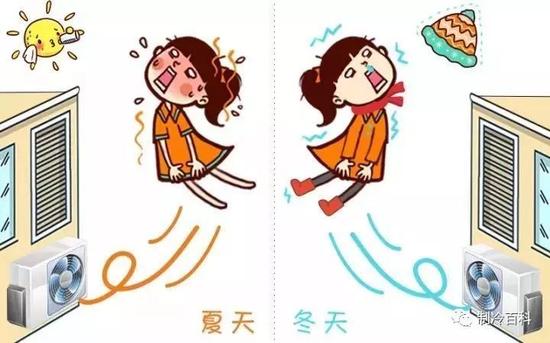To explain which white air conditioning refrigeration, heating which is more power-hungry, please also ask your friends to think about it: Is it necessary to detour every time you pass the air conditioner outside the machine, the farther the better! After all, a wave of heat The heat wave and the cold wind in the cold winter are indeed very sour...

This kind of scene of ice and fire inside and outside is the simplest principle of air conditioning refrigeration and heating: the exchange of indoor heat and outdoor heat. In the winter, the outdoor heat is “handed†indoors; in the summer, the indoor heat is “handed†outside.
How does the air conditioner as a “porter†work? Today, the refrigeration encyclopedia simply talks about it~
Move the small bench to listen to it~
The general air conditioner is composed of four major components: compressor, condenser, expansion valve and evaporator. It can choose to install auxiliary devices such as pressure controller, temperature controller and drying filter according to the control or use requirements, but four large parts. It is essential. When working, the gaseous refrigerant is compressed into high temperature and high pressure gas through the compressor, and then enters the condenser. The condenser is equivalent to a heat exchange device, and the high temperature and high pressure gaseous refrigerant is exchanged into a low temperature and low pressure liquid refrigerant. The liquid refrigerant passes through the expansion valve. The so-called expansion valve is a throttling device. Because the refrigerant flowing out of the expansion valve is contained, the pressure of the refrigerant is lowered after the pressure is released, and the temperature continues to decrease, becoming a gas-liquid two phase and then entering the evaporator. At this time, the refrigerant re-evaporator performs heat exchange vaporization, and the high-temperature low-pressure gas refrigerant returns to the compressor to continue the circulation.
   The household air conditioner is generally a cooling system of air-cooled cold air (the central air conditioner also includes water-cooled cold air, water-cooled cold water, air-cooled cold water, etc., the front refers to the heat exchange form of the condenser, and the latter word refers to the heat exchange form of the evaporator), That is to say, during cooling, the refrigerant exchanges heat in the condenser, and the evaporator is blown by the fan, and the evaporator is relatively low in temperature relative to the room temperature, so that the cold air is naturally blown out. If the air conditioner has a heating function, a check valve and a four-way valve are installed on the refrigerant system after the compressor is discharged, and the two functions are to change the flow direction of the refrigerant, and at this time, the condenser and the system in the cooling system The functions of the evaporator are interchanged, that is, the condenser at the time of cooling becomes an evaporator at the time of heating, and the evaporator at the time of cooling becomes a condenser at the time of heating. Therefore, the fan blows the evaporator during cooling, and now the condenser is blown, so the hot air is blown out.
Air conditioning, cooling, electricity, or heating, electricity, air conditioning, cooling, or heating?
Because the motor power is constant, in the absolute sense, the power consumption should be the same, but it is complicated to explain this. An important parameter to measure the air conditioning working capacity is the COP value, which is often said. The energy consumption ratio is, in layman's terms, the amount of cold energy that I can generate when I consume 1KW of electricity. The higher the COP, the better the performance. Because in the air conditioning design, the selection of each component is usually based on the cooling conditions. In the case of cooling, the heat exchange capacity of the condenser is usually equal to the sum of the cooling capacity and the heat loss of the compressor, and the heat exchange amount of the evaporator is equal to the cooling capacity of the unit, that is, usually the condenser has a larger heat exchange capacity than the evaporator. Therefore, the heating capacity of the air conditioner is worse, that is to say, under rated conditions (usually selected rated conditions, convenient comparison), the cooling COP value is greater than the heating COP value. It can be seen that the same loss of 1 degree of electricity, the cooling capacity is greater than the heating capacity, or conversely, in the case of the same amount of cooling and heating, the electricity consumed during heating is more, therefore, why is heating more power consumption? This is the reason.
Liquid Crystal Display For Medical Use
Liquid Crystal Display For Medical Use,Super Liquid Crystal Instrument Medical Display,Medical Liquid Crystal Instrument Lcd Display,Thin Transparent Lcd Medical Display
Dongguan Yijia Optoelectronics Co., Ltd. , http://www.everbestlcdlcm.com